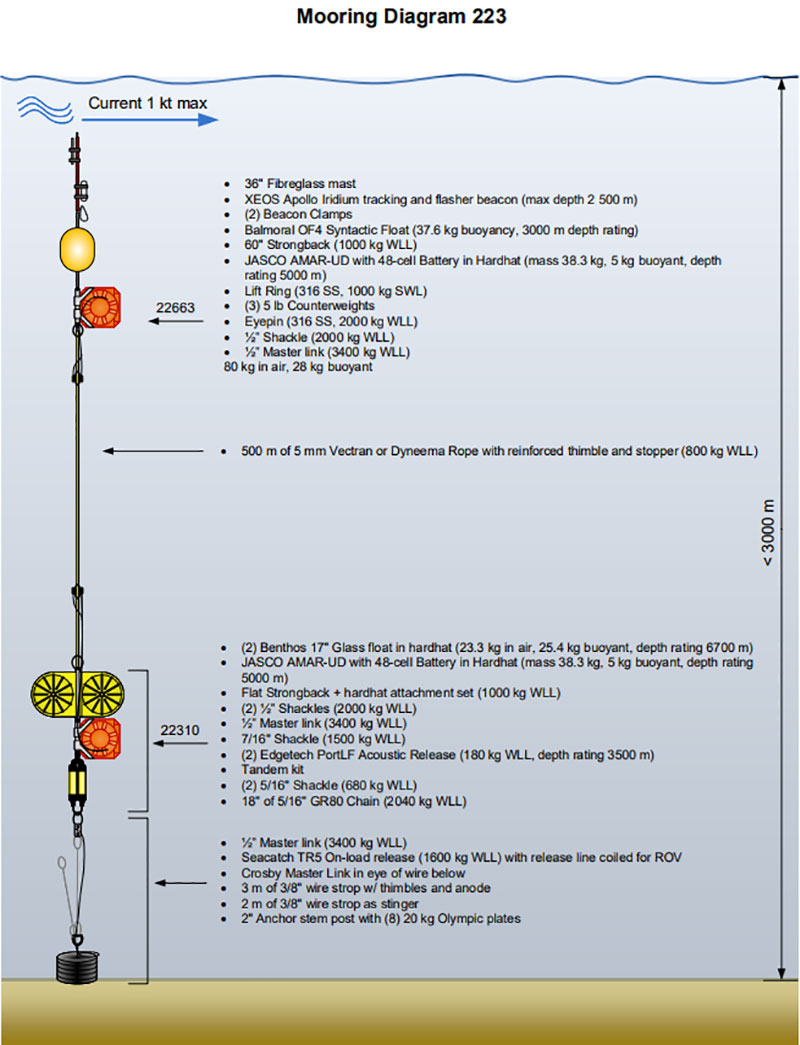
by Robert Mills, JASCO Applied Sciences
December 6, 2018

Chief Bosun Mike Collins, Larry Mayer (University of New Hampshire - Center for Coastal and Ocean Mapping) and Robert Mills (JASCO) payout the hydrophone array mooring line. Image courtesy of Levi Unema, GFOE. Download larger version (jpg, 4.3 MB).
Hello, I’m Robert Mills, Senior Field Technician for JASCO Applied Sciences. I’m on board NOAA Ship Okeanos Explorer to deploy a deepwater acoustic mooring. I’m part of the multibeam sonar soundscape study for University of New Hampshire.
Our mooring has two of JASCO’s AMARs (Autonomous Multichannel Acoustic Recorders). The AMARs will record the sound projected by various multibeam configurations. We can use this information to better understand the sound signature of the sonar and its effect on the environment.

Diagram of the deployed hydrophone array. Image courtesy of JASCO Applied Sciences. Download image (jpg, 134 KB).
AMARs are highly sensitive acoustic recorders that are entirely autonomous of a deck control system. They can record soundscapes for months on end. JASCO’s recorders are used worldwide for precisely measuring all kinds of sound sources in the ocean.
For this array, we’re using AMAR UDs (Ultra Deeps) that can submerge to over 6,000 meters (3.7 miles). They are housed in strong glass sphere, with each AMAR having two hydrophones. Each hydrophone has a different sensitivity so we can listen to different characteristics of the Okeanos Explorer’s multibeam sonar.

Mike Smith (University of New Hampshire - Center for Coastal and Ocean Mapping), Robert Mills (JASCO), Lt. Nick Pawlenko (NOAA Office of Ocean Exploration and Research), and Patrick Bordner (U.S. Navy) search the horizons during hydrophone recovery. The array was triggered from its mooring using an acoustic signal and took about an hour to float up to the surface. Image courtesy of Levi Unema, GFOE. Download larger version (jpg, 3.5 MB).

A portion of the hydrophone array at the ocean surface. These hardhats contain a glass float for buoyancy and the battery cell. Image courtesy of Levi Unema, GFOE. Download map (jpg, 6.2 MB).
At the end of the study, I’ll use two tandem acoustic releases that trigger the mooring to detach from its anchor. The mooring will float to the surface, and the deck crew and I will pull it back onboard and collect the data.
December 7, 2018 update: We successfully recovered the hydrophone array after acoustically releasing it from its mooring on the seafloor.